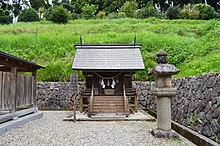
Ashinazuchi and Tenazuchi (アシナヅチ・テナヅチ) is a pair of Japanese deities[1]
In ancient Japanese stories called the Kojiki and the Nihon Shoki, there was a god named Susanoo who was sent away from his home in the heavens to live on Earth in a place called Izumo. There, he met an old couple named Ashinazuchi and Tenazuchi who were children of a mountain god called Ōyamatsumi. They told him about a scary monster called Yamata no Orochi, which had eaten seven of their eight daughters. Susanoo offered to kill the monster if they would give him their only surviving daughter, Kushinadahime, to be his wife.[2][3]
Susano'o defeated Orochi and built a palace in the land of Suwa Province. He then appointed Ashinazuchi as the leader of the palace and gave him the name Inada no Miyatsuko Suga no Yatsunomimi no Kami (稲田宮使諏訪之八意名神)
Family tree
[change | change source]| Susanoo[4][5] | Ōyamatsumi[6] | ||||||||||||||||||||||||||||||||||||||||||
| Ashinazuchi[7] | Tenazuchi | Konohanachiruhime[8] | |||||||||||||||||||||||||||||||||||||||||
| Kushinadahime[9] | |||||||||||||||||||||||||||||||||||||||||||
| Yashimajinumi[8] | |||||||||||||||||||||||||||||||||||||||||||
| Kagutsuchi[10] | |||||||||||||||||||||||||||||||||||||||||||
| Kuraokami[11] | |||||||||||||||||||||||||||||||||||||||||||
| Hikawahime[12] | Fuha-no-Mojikunusunu[13] | ||||||||||||||||||||||||||||||||||||||||||
| Fukabuchi-no-Mizuyarehana | Ame-no-Tsudoechine | Funozuno | |||||||||||||||||||||||||||||||||||||||||
| Sashikuni Okami | Omizunu | Futemimi | |||||||||||||||||||||||||||||||||||||||||
| Sashikuniwakahime | Ame-no-Fuyukinu[14][15] | Takamimusubi | |||||||||||||||||||||||||||||||||||||||||
| Futodama | |||||||||||||||||||||||||||||||||||||||||||
| Nunakawahime | Ōkuninushi[16] (Ōnamuchi)[17] | Kamotaketsunumi no Mikoto | |||||||||||||||||||||||||||||||||||||||||
| Kotoshironushi[18] | Tamakushi-hime | Takeminakata | Susa Clan[19] | ||||||||||||||||||||||||||||||||||||||||
| JAPANESE EMPERORS | |||||||||||||||||||||||||||||||||||||||||||
| 711–585 BC Jimmu 660–585 BC(1) | Himetataraisuzu-hime[20] | Kamo no Okimi | |||||||||||||||||||||||||||||||||||||||||
| 632–549 BC Suizei 581–549 BC(2) | Isuzuyori-hime | Hikoyai | Kamuyaimimi d.577 BC | Miwa clan | |||||||||||||||||||||||||||||||||||||||
* Pink is female. * Blue is male. * Grey means other or unknown. * Clans, families, people groups are in green.
References
[change | change source]- ↑ Fr?d?ric, L.; Louis-Frédéric; Roth, K. (2005). Japan Encyclopedia. Harvard University Press reference library. Belknap Press of Harvard University Press. ISBN 978-0-674-01753-5. Retrieved 2020-11-21.
- ↑ Chamberlain (1882). Section XVIII.—The Eight-Forked Serpent.
- ↑ Philippi, Donald L. (2015). Kojiki. Princeton University Press. pp. 89–90. ISBN 978-1400878000.
- ↑ Atsushi, Kadoya (10 May 2005). "Susanoo". Encyclopedia of Shinto. Retrieved 2010-09-29.
- ↑ "Susanoo | Description & Mythology". Encyclopedia Britannica.
- ↑ Kaoru, Nakayama (7 May 2005). "Ōyamatsumi". Encyclopedia of Shinto. Retrieved 2010-09-29.
- ↑ Fr?d?ric, L.; Louis-Frédéric; Roth, K. (2005). Japan Encyclopedia. Harvard University Press reference library. Belknap Press of Harvard University Press. ISBN 978-0-674-01753-5. Retrieved 2020-11-21.
- ↑ 8.0 8.1 "Encyclopedia of Shinto - Home : Kami in Classic Texts : Yashimajinumi". eos.kokugakuin.ac.jp.
- ↑ "Encyclopedia of Shinto - Home : Kami in Classic Texts : Kushinadahime". eos.kokugakuin.ac.jp.
- ↑ "Kagutsuchi". World History Encyclopedia.
- ↑ Ashkenazi, M. (2003). Handbook of Japanese Mythology. Handbooks of world mythology. ABC-CLIO. p. 213. ISBN 978-1-57607-467-1. Retrieved 2020-11-21.
- ↑ Chamberlain, B.H. (2012). Kojiki: Records of Ancient Matters. Tuttle Classics. Tuttle Publishing. ISBN 978-1-4629-0511-9. Retrieved 2020-11-21.
- ↑ Herbert, J. (2010). Shinto: At the Fountainhead of Japan. Routledge Library Editions: Japan. Taylor & Francis. p. 402. ISBN 978-1-136-90376-2. Retrieved 2020-11-21.
- ↑ Philippi, Donald L. (2015). Kojiki. Princeton University Press. p. 92.
- ↑ Chamberlain (1882). Section XX.—The August Ancestors of the Deity-Master-Of-The-Great Land.
- ↑ Atsushi, Kadoya; Tatsuya, Yumiyama (20 October 2005). "Ōkuninushi". Encyclopedia of Shinto. Retrieved 2010-09-29.
- ↑ Atsushi, Kadoya (21 April 2005). "Ōnamuchi". Encyclopedia of Shinto. Retrieved 2010-09-29.
- ↑ Atsushi, Kadoya (28 April 2005). "Kotoshironushi". Encyclopedia of Shinto. Retrieved 2010-09-29.
- ↑ Tanigawa Ken'ichi 『日本の神々 神社と聖地 7 山陰』(新装復刊) 2000年 白水社 ISBN 978-4-560-02507-9
- ↑ Kazuhiko, Nishioka (26 April 2005). "Isukeyorihime". Encyclopedia of Shinto. Retrieved 2010-09-29.